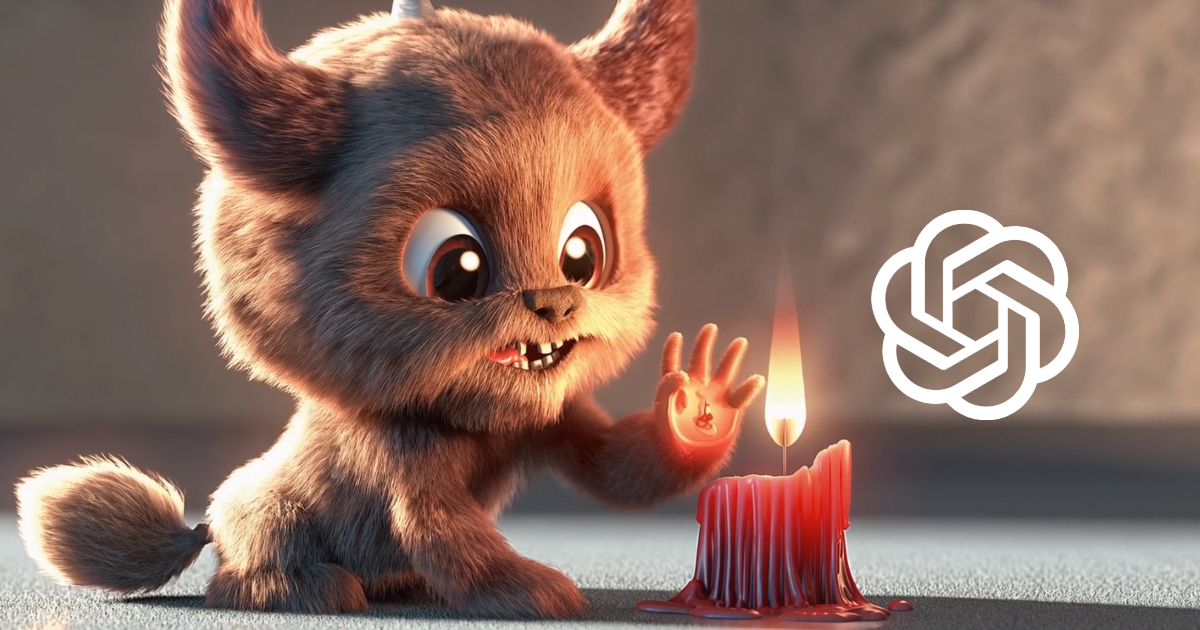In mid-February, OpenAI introduced a new generative network that is capable of generating very high-quality video by text format. It's called Sora. We talked about its prospects in the gaming industry with teams that have already implemented other neural networks into their pipeline. Our experts include representatives of Charisma, Playkot, Lost Lore, Skywaylab and ZiMAD.
So far, OpenAI has only shown the capabilities of Sora. What are your impressions of the published examples?
Guy Gadney — CEO and Co-founder of Charisma
It looks like Sora has solved one of the most difficult tasks in the field of image generation — frame consistency. Where most other AI distort or hallucinate, Sora realistically displays human movements and retains the shape of buildings. This is a turning point in the history of generative AI, which will have a profound impact on the creation of short videos.
Of course, after the launch, you should expect a ton of messages in the spirit of "I entered [xxx] into Sora and just look at what it has created." But, as with ChartGPT, it won't last long. The foam will settle as soon as the service is mastered by creative people who will start using it to solve specific artistic tasks.
Anyway, in terms of importance, the appearance of Sora can be compared with the invention of a home video camera.
Evgeny Smirnov, Casual CPO Playkot
The fact that so far OpenAI has talked about the possibility of Sora looks like a very big breakthrough for AI. And not only from the point of view of video generation. This technology has an impressive practical potential for both simulating real and virtual worlds. And modeling future scenarios is a very important stage in the development of AGI.
Evgeny Kitkin, Founder and CEO of Lost Lore Studio
Every time I see a new product from OpenAI, I think that I need to retrain again, evolve the company again, and rebuild the processes. In the case of Sora, it's the same story. More flexible companies will be able to bypass large ones — in advertising, in prototyping, in attracting attention in all areas, not only in game development. The world will change again.
Alexey Yemelyanov, one of the founders of Skywaylab
With the capabilities that OpenAI provides in their latest Sora development, a unique future for the video industry opens up before us. Sora not only demonstrates the ability to generate video content based on text descriptions, but also provides us with a perspective where each viewer can influence the plot development and details of the video, making them unique and personalized. This could mean revolutionary changes not only in the way entertainment content is consumed, but also in the advertising industry.
I see a world in the future in which each viewer can change the film independently in real time, for example, make the ending of the film happy instead of dramatic, or change the storyline according to their preferences. Most likely, this will enhance emotional engagement and open up new horizons of interactivity.
In the field of advertising, thanks to Sora, we can expect the appearance of fully individualized commercials, precisely aimed at the interests and preferences of a particular user. This will certainly reduce the CPI and increase the effectiveness of advertising campaigns.
If you look even more broadly, Sora will definitely have a strong impact on educational projects. In the future, we can expect the appearance of educational videos that automatically adapt to the level of knowledge and interests of the student, making learning more interesting and personality-oriented.
I believe that now is a time of great opportunities. We look forward to accessing this tool to explore everything in practice.
Kirill Zhukovsky, CPO ZiMAD
Sora was impressed by the quality of the sample videos, but this is not the only solution of its kind. The service has a number of competitors. Together, they are creating a revolution in video production. Right now, they can replace stock videos, to some extent devaluing the work of independent videographers who put short videos up for sale.
In what area related to game development will Sora be able to find application?
Evgeny Smirnov, Casual CPO Playkot
If you look at the "here and now", then Sora can be useful in such use cases as helping with the search for marketability of new projects and the development of advertising creatives. Also, such AI tools can be a good help in tasks related to automation and optimization. This is important because the audience is still waiting for a game with a cool production value, but at the same time the situation in the mobile market is becoming more complicated, and companies are less willing to take risks and do high-budget projects.
If we talk about the future, then we can come to completely different pipelines. For example, switch to AI rendering, when everything that happens is constructed through simplified lowres graphics and then generated into cooler, more detailed and vivid graphics, simultaneously adding simulation of more complex processes inside the game. Another example is that such technologies can significantly automate the work of artists: based on their minimal drafts, concept art, 3D models and animation can be completed. Such AI can also help with the generation of game prototypes through a cascade of neural networks of different specializations.
Evgeny Kitkin, Founder and CEO of Lost Lore Studio
Imagine that we can test the gameplay without developing a prototype, using playable and video ads to create more content, faster, cheaper. Choose-Your-Own-Adventure games will reach a whole new level of immersion — they will be able to create entire locations in real time. And what will happen to gaming streaming services if such technology starts generating gameplay or a camera flying over a location in real time, depending on the actions of the players!
Alexey Yemelyanov, one of the founders of Skywaylab
In game development, Sora will definitely affect both development and marketing. Here are the directions that come to mind first.
- On-the-fly content creation: Sora can be used to generate dynamic scenes, characters, and even entire worlds based on real-time text descriptions. This will allow developers to quickly experiment with different storylines and visual styles, significantly reducing production time and costs.
- Personalized gameplay: Games can become more flexible by offering each player a unique storyline, personalized quests, or even unique worlds to explore. There will be such a thing as a unique gaming experience that will not be available to other people. In this regard, engagement should increase, and game streamers may become even more popular.
- Game marketing: this is our field and we are fully aware that the appearance and possibility of using such tools is a great gift to the whole game rendezvous. You just need to learn how to do it correctly and all game developers will be able to get out of the crisis faster and ROAS will noticeably increase. This will especially give small game studios a good chance to grow (due to their greater flexibility and audacity in experiments).
Kirill Zhukovsky, CPO ZiMAD
In game development, Sora will be able to find application in creating advertising creatives. It can be a gift for indie developers who do not have the funds and skills for video production. Theoretically, it is possible that Sora will allow you to make cut scenes, but at the current stage of development, it is unlikely that you will be able to assemble a high-quality game in this way. But it is quite possible to create a presentation for investors.
Are you already trying on whether there will be a place for Sora in your pipeline?
Evgeny Smirnov, Casual CPO Playkot
We are closely monitoring all innovations. And we definitely see several potential use cases, such as the development of gameplay videos for fake—shot creatives, the development of advertising creatives, optimization of cinematics development and automation of animation development.
Evgeny Kitkin, Founder and CEO of Lost Lore Studio
Lost Lore has been using neural networks since 2022. In 2023, we have already developed three games using Midjourney, Stable Diffusion, Stable Video Diffusion (we use it to create animations for characters and environments), and several audio AI (including for voice acting), and also actively used ChatGPT4 for narrative and game design.
We are one of the few AI studios that explores the Theresanaiforth website on a weekly basis and tries to apply new neural networks to the studio's daily tasks. As a result, we make more content faster and get a better end result.
So, there will definitely be a Sora place in our pipeline. We will try to become its users at the stage of a closed test, if there is one.
Alexey Yemelyanov, one of the founders of Skywaylab
At Skywaylab, we test all the tools that appear on the market and, despite the fact that we have not yet gained access to Sora, our meetups with the team showed that the tool has good potential to accelerate and reduce the cost of testing marketing hypotheses, and this is a key aspect in creating advertising campaigns.
However, our interest in Sora is not limited to creatives for buying traffic. We see great prospects in the direction of viral content to attract traffic on social networks such as YouTube, TikTok and Instagram. Despite the difficulties with traffic quality control, in our opinion, this channel will be extremely important for game dev, as it offers access to a large audience at a relatively low cost. Using Sora will allow us to significantly speed up and simplify the process of creating viral gaming content, making it more accessible and effective for our customers.
We see Sora not just as a tool for automating video creation, but also as an opportunity to experiment with new formats and approaches to advertising. This may include creating personalized commercials that directly address the interests and preferences of the target audience, as well as developing dynamic content that can adapt to current trends and the interests of viewers in real time.
As a result, technology opens the door to creating deeper and more engaging content that can attract a huge number of players and keep them interested for a long time, which ultimately reduces the cost of attracting and increases the overall effectiveness of our campaigns.
Kirill Zhukovsky, CPO ZiMAD
Specifically, we are not trying Sora on our processes right now, but we are looking at this and other similar solutions.
What pitfalls/limitations in terms of use in development do you see in Sora?
Evgeny Smirnov, Casual CPO Playkot
It is not yet known what level of control Sora users will have over the generation results, and it depends on how we could use the technology in our work. It is also unclear how Sora will be further trained to adapt to the tasks of specific users and teams.
Evgeny Kitkin, Founder and CEO of Lost Lore Studio
There will be a limit on the length of the created video on OpenAI servers, and it is unlikely that they will be allowed to install on their own servers due to the proprietary architecture (most likely, Sora has several layers of neurons). The video creation time will be long, not suitable for regular use at first.
I would also raise the issue of the safety of this technology. For this reason, the product is still not publicly available.
Alexey Yemelyanov, one of the founders of Skywaylab
We don't see a lot of pitfalls yet, but they are quite significant. The introduction of innovative technologies is always associated with certain challenges and limitations.
- Legal and ethical issues: One of the key pitfalls of using AI content generation technology is copyright and intellectual property issues. Determining who owns the rights to AI-generated content can be difficult, and there may also be disputes about the use of protected materials without permission.
- Quality control: When generating video content using Sora, there may be a problem with ensuring stable and predictable quality. AI algorithms can interpret text descriptions in different ways, which will lead to ambiguous results. It is necessary to develop control and correction mechanisms to ensure that the generated content meets the stated quality standards and expectations.
- Data dependence: The quality and variety of the generated content directly depend on the training data on which the model was trained. There is a risk that the model may reproduce existing biases or not have enough diversity in the data to create content conceived by a creative producer.
In conclusion, I would like to add that, despite all the potential pitfalls and difficulties in introducing new technologies into existing pipelines and processes, this must be done, otherwise there is a chance to be left behind the ship sailing to success.
Kirill Zhukovsky, CPO ZiMAD
Of course, there are pitfalls. The most important problem is the often unpredictable result and a small number of settings. Some scenes are likely to be difficult to glue together properly due to the strong differences in camera angles, dynamics, lighting and the appearance of the characters. Over time, there will be more settings, but due to random results, the tool will not be ready for full-fledged professional use soon.






